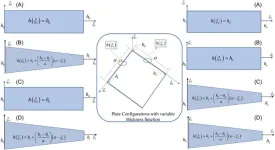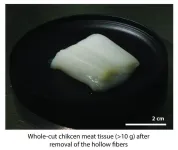(Press-News.org) Astronomers have found a planet that orbits at an angle of 90 degrees around a rare pair of peculiar stars. This is the first time we have strong evidence for one of these ‘polar planets’ orbiting a stellar pair. The surprise discovery was made using the European Southern Observatory’s Very Large Telescope (VLT).
Several planets orbiting two stars at once, like the fictional Star Wars world Tatooine, have been discovered in the past years. These planets typically occupy orbits that roughly align with the plane in which their host stars orbit each other. There have previously been hints that planets on perpendicular, or polar, orbits around binary stars could exist: in theory, these orbits are stable, and planet-forming discs on polar orbits around stellar pairs have been detected. However, until now, we lacked clear evidence that these polar planets do exist.
“I am particularly excited to be involved in detecting credible evidence that this configuration exists,” says Thomas Baycroft, a PhD student at the University of Birmingham, UK, who led the study published today in Science Advances.
The unprecedented exoplanet, named 2M1510 (AB) b, orbits a pair of young brown dwarfs — objects bigger than gas-giant planets but too small to be proper stars. The two brown dwarfs produce eclipses of one another as seen from Earth, making them part of what astronomers call an eclipsing binary. This system is incredibly rare: it is only the second pair of eclipsing brown dwarfs known to date, and it contains the first exoplanet ever found on a path at right angles to the orbit of its two host stars.
“A planet orbiting not just a binary, but a binary brown dwarf, as well as being on a polar orbit is rather incredible and exciting,” says co-author Amaury Triaud, a professor at the University of Birmingham.
The team found this planet while refining the orbital and physical parameters of the two brown dwarfs by collecting observations with the Ultraviolet and Visual Echelle Spectrograph (UVES) instrument on ESO's VLT at Paranal Observatory, Chile. The pair of brown dwarfs, known as 2M1510, were first detected in 2018 by Triaud and others with the Search for habitable Planets EClipsing ULtra-cOOl Stars (SPECULOOS), another Paranal facility.
The astronomers observed the orbital path of the two stars in 2M1510 being pushed and pulled in unusual ways, leading them to infer the existence of an exoplanet with its strange orbital angle. “We reviewed all possible scenarios, and the only one consistent with the data is if a planet is on a polar orbit about this binary,” says Baycroft [1].
“The discovery was serendipitous, in the sense that our observations were not collected to seek such a planet, or orbital configuration. As such, it is a big surprise,” says Triaud. “Overall, I think this shows to us astronomers, but also to the public at large, what is possible in the fascinating Universe we inhabit.”
Notes
[1] In the new Science Advances study, 2M1510 or 2M1510 AB are the names given to the eclipsing binary of two brown dwarfs, 2M1510 A and 2M1510 B. The same system is known to have a third star, orbiting at large distance from the pair, which the study authors call 2M1510 C. The study shows this third star is too far away to cause the orbital disturbances.
More information
This research was presented in a paper to appear in Science Advances titled “Evidence for a polar circumbinary exoplanet orbiting a pair of eclipsing brown dwarfs” (https://doi.org/10.1126/sciadv.adu0627).
The team is composed of: T. A. Baycroft (University of Birmingham, Birmingham, United Kingdom), L. Sairam (University of Birmingham, Birmingham, United Kingdom; University of Cambridge, Cambridge, United Kingdom), A. H. M. J. Triaud (University of Birmingham, Birmingham, United Kingdom), and A. C. M. Correia (Universidade de Coimbra, Coimbra, Portugal; Observatoire de Paris, Université PSL, France).
The European Southern Observatory (ESO) enables scientists worldwide to discover the secrets of the Universe for the benefit of all. We design, build and operate world-class observatories on the ground — which astronomers use to tackle exciting questions and spread the fascination of astronomy — and promote international collaboration for astronomy. Established as an intergovernmental organisation in 1962, today ESO is supported by 16 Member States (Austria, Belgium, Czechia, Denmark, France, Finland, Germany, Ireland, Italy, the Netherlands, Poland, Portugal, Spain, Sweden, Switzerland and the United Kingdom), along with the host state of Chile and with Australia as a Strategic Partner. ESO’s headquarters and its visitor centre and planetarium, the ESO Supernova, are located close to Munich in Germany, while the Chilean Atacama Desert, a marvellous place with unique conditions to observe the sky, hosts our telescopes. ESO operates three observing sites: La Silla, Paranal and Chajnantor. At Paranal, ESO operates the Very Large Telescope and its Very Large Telescope Interferometer, as well as survey telescopes such as VISTA. Also at Paranal ESO will host and operate the Cherenkov Telescope Array South, the world’s largest and most sensitive gamma-ray observatory. Together with international partners, ESO operates ALMA on Chajnantor, a facility that observes the skies in the millimetre and submillimetre range. At Cerro Armazones, near Paranal, we are building “the world’s biggest eye on the sky” — ESO’s Extremely Large Telescope. From our offices in Santiago, Chile we support our operations in the country and engage with Chilean partners and society.
The University of Birmingham is ranked amongst the world’s top 100 institutions. Our work brings people from across the world to Birmingham, including researchers, teachers and more than 8,000 international students from over 150 countries.
Links
Research paper
Photos of the VLT
For journalists: subscribe to receive our releases under embargo in your language and apply to take part in ESO's (partly funded) 2025 strategic media visit (NEW)
For scientists: got a story? Pitch your research
New ESO analysis confirms severe damage from industrial complex planned near Paranal
Contacts
Thomas Baycroft (English, French)
School of Physics and Astronomy, University of Birmingham
Birmingham, UK
Email: txb187@student.bham.ac.uk
Amaury Triaud (French, English, Spanish)
School of Physics and Astronomy, University of Birmingham
Birmingham, UK
Tel: +44 121 414 4553
Email: A.Triaud@bham.ac.uk
Bárbara Ferreira
ESO Media Manager
Garching bei München, Germany
Tel: +49 89 3200 6670
Cell: +49 151 241 664 00
Email: press@eso.org
Press office
University of Birmingham
Birmingham, UK
Tel: +44 (0) 121 414 2772
Email: pressoffice@contacts.bham.ac.uk
END
"Big surprise": astronomers find planet in perpendicular orbit around pair of stars
2025-04-16
ELSE PRESS RELEASES FROM THIS DATE:
Astronomers find rare twist in exoplanet’s twin star orbit
2025-04-16
Astronomers have discovered a planet that orbits at a 90-degree angle around a rare pair of strange stars – a real-life ‘twist’ on the fictional twin suns of Star Wars hero Luke Skywalker’s home planet of Tatooine.
The exoplanet, named 2M1510 (AB) b, orbits a pair of young brown dwarfs — objects bigger than gas-giant planets but too small to be proper stars. Only the second pair of eclipsing brown dwarfs known – this is the first exoplanet found on a right-angled path to the orbit of its two host stars.
An international team of researchers led ...
Crystal clues on Mars point to watery and possibly life-supporting past
2025-04-16
A QUT-led study analysing data from NASA’s Perseverance rover has uncovered compelling evidence of multiple mineral-forming events just beneath the Martian surface – findings that bring scientists one step closer to answering the profound question: did life ever exist on Mars?
The QUT research team led by Dr Michael Jones, from the Central Analytical Research Facility and the School of Chemistry and Physics, includes Associate Professor David Flannery, Associate Professor Christoph Schrank, Brendan Orenstein and Peter Nemere, together with researchers from North America and Europe.
The findings were published in the prestigious journal ...
Microbes in Brooklyn Superfund site teach lessons on fighting industrial pollution
2025-04-16
Using advanced DNA sequence analysis, a research team led by NYU Tandon School of Engineering's Assistant Professor Elizabeth Hénaff has discovered that tiny organisms in Brooklyn's highly contaminated Gowanus Canal have developed a comprehensive collection of pollution-fighting genes.
The findings were published in the Journal of Applied Microbiology on April 15, 2025.
The team identified 455 species of microorganisms wielding 64 different biochemical pathways to degrade pollutants ...
Porous and powerful: How multidirectional grading enhances piezoelectric plate performance
2025-04-16
Piezoelectric materials have long been celebrated for their ability to convert mechanical energy into electrical energy, making them indispensable in smart systems for sensing, actuation, and vibration control. However, incorporating porosity and multidirectional grading into these materials introduces a host of challenges in understanding their behavior under varying environmental conditions. These complexities are further compounded by the interaction of hygrothermal conditions with electrical and mechanical loads. As a result, there is a pressing need for more in-depth research to predict the real-world performance of these materials.
Published ...
Study finds dramatic boost in air quality from electrifying railways
2025-04-16
Switching from diesel to electric trains dramatically improved the air quality aboard the San Francisco Bay Area’s Caltrain commuter rail line, reducing riders’ exposure to the carcinogen black carbon by an average of 89%, finds a new study published today in the journal Environmental Science and Technology Letters.
The electrification of the system also significantly reduced the ambient black carbon concentrations within and around the San Francisco station, the study found.
“The transition from diesel to electric trains occurred over just a few weeks, and yet we saw the same drop in black carbon concentrations in the station as California ...
Bite-sized chunks of chicken with the texture of whole meat can be grown in the lab
2025-04-16
A bioreactor that mimics a circulatory system can deliver nutrients and oxygen to artificial tissue, enabling the production of over 10 grams of chicken muscle for cultured meat applications. These results are publishing in the Cell Press journal Trends in Biotechnology on April 16.
“Our study presents a scalable, top-down strategy for producing whole-cut cultured meat using a perfusable hollow fiber bioreactor,” says senior author Shoji Takeuchi of The University of Tokyo. “This system enables cell distribution, alignment, contractility, ...
A compact, mid-infrared pulse generator
2025-04-16
Physicists in the Harvard John A. Paulson School of Engineering and Applied Sciences (SEAS) have created a compact laser that emits extremely bright, short pulses of light in a useful but difficult-to-achieve wavelength range, packing the performance of larger photonic devices onto a single chip.
Published in Nature, the research is the first demonstration of an on-chip, picosecond, mid-infrared laser pulse generator that requires no external components to operate. The device can make what’s called an optical frequency comb, a spectrum of light consisting of equally spaced frequency lines (like a comb), used today in precision measurements. ...
Sex-based differences in binge and heavy drinking among US adults
2025-04-16
About The Study: This analysis found that past-month binge drinking among young adult females in 2021-2023 was higher than males, reversing 2017-2019 patterns, whereas males in other age groups continued to binge and heavy drink at higher rates. These findings may be due to more rapid decreases in binge drinking over time among young adult males relative to females, or to plateauing or increases in binge drinking among females. Further investigation using other nationally representative surveys is needed to elucidate these explanations.
Corresponding Author: To contact the corresponding author, Bryant Shuey, MD, MPH, email bryant.shuey@pitt.edu.
To ...
Using vibrations to see into Yellowstone's magma reservoir
2025-04-16
Beneath Yellowstone lies a magma reservoir, pulsing with molten and superheated rock and exsolved gases. Scientists have long known about the chamber’s existence, but have yet to precisely locate its uppermost boundary and characterize the contents of the chamber closest to the surface—information crucial for understanding the potential perils this volcanic feature poses.
That changed this week with new research by seismologists from the University of Utah and the University of New Mexico (UNM) who used hundreds of portable seismometers and a mechanical vibration source to render 2D seismic reflection images of the ground beneath Yellowstone’s caldera.
Using ...
From disorder to order: scientists rejuvenate aging batteries
2025-04-16
A team of scientists led by Prof. LIU Zhaoping at the Ningbo Institute of Materials Technology and Engineering (NIMTE) of the Chinese Academy of Sciences, in collaboration with researchers from the University of Chicago and other institutions, has developed zero thermal expansion (ZTE) materials. This innovation has achieved nearly 100% voltage recovery in aging lithium-ion batteries (LIBs), as detailed in a study published in Nature.
LIBs have become increasingly essential in the markets for electric vehicles and aircraft. Lithium-rich layered oxide cathode materials can deliver record capacities exceeding 300 mAh/g, thanks to revolutionary oxygen-redox (OR) ...







